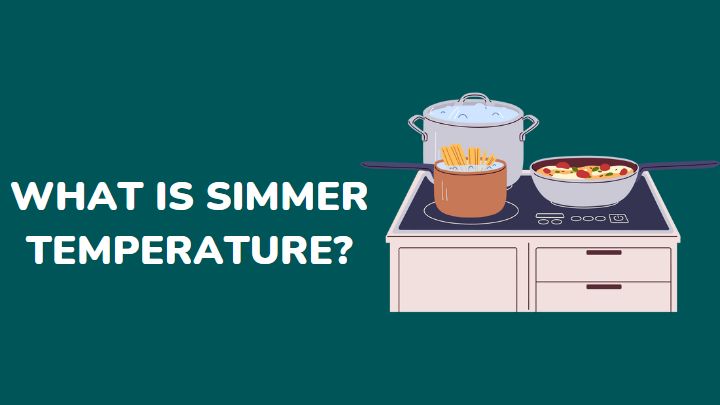To simmer means to cook food in liquid at any temperature between 185°F to 205°F. The different cooking methods are differentiated by the level of heat you apply.
Simmering works well with different cooking appliances like the stove and oven. And because each cooking appliance works differently, the simmering temperature for each will certainly differ.
Simmering can be tricky because while it looks like you’re boiling, you are not. So, you may be boiling while you think you’re simmering.
To help you out, I have put this article together to explain what it means to simmer, the simmering temperature, and the difference between simmering and boiling.
What does it mean to bring to a simmer?
To bring a dish to a simmer means to cook gently and soften items like meat, potatoes, carrots, legumes, grains, and greens like beets.
Also, you can simmer just liquid with seasonings and ingredients. Furthermore, simmering shares some similarities with boiling and poaching.
But simmering cooks a dish below the temperature for boiling and above the temperature for poaching.
When a liquid like water simmers, the bubbles rise from the bottom to the top. Simmering requires that you keep the temperature balanced to get the food tender but not overcooked.
In addition, while simmering helps to achieve your desired level of doneness, it enhances the flavor of your dish. It also prevents nutrient loss.
What is the simmering temperature for a stove?
The simmer temperature for a stove is any value between 185°F and 205°F.
At any value within this range, you can cook your meal slowly to get the best out of it.
You should know that some stoves work with a numbering system. If you have a stove like this, it might have the “simmer” label, which makes things easier.
But, if your stove does not have this label, the simmer setting falls within numbers 3 & 4 and 2 & 3 on a nine-numbered and six-numbered stove, respectively.
What is the ideal simmer temperature for ovens?
The simmer temperature for an oven is between 185°F and 205°F.
You’ll observe that this is the same temperature for simmering on a stovetop; work with it. Most importantly, keep an eye on your dish. Take it out of the oven when you’re sure it’s simmering.
What is the right simmer temperature for an electric skillet?
To simmer in an electric skillet, set the skillet to 200°F or use the simmer option on the control.
Start by bringing the dish to a boil. Afterward, you can adjust the temperature to the simmer option or 200°F.
What is the simmer temperature range for an induction cooker?
The simmer temperature on an induction cooker is between 180°F to 195°F.
Any value beyond this temperature range on an induction cooker will cook your food with too much heat.
Is simmer low or high heat?
Simmer is neither low nor high heat.
To simmer means to cook on medium-low heat. The heat level is lower than medium but not as low as low heat.
How to maintain simmer temperature
- Do not raise the temperature
- Keep the lid off the pot to prevent boiling and evaporation
- Also, stir the dish occasionally
- If you find it hard to regulate the temperature, remove the pot from heat once the liquid begins to boil. Then, return it after a few minutes
What is the difference between simmering and boiling?
To start with, the difference between simmering and boiling is the temperature.
Boiling happens at 212°F while simmering starts at 185°F. Also, when simmering, the liquid breaks out with tiny bubbles on the surface, while boiling sends rolling bubbles from the bottom to the top.
In addition, each cooking method has a different culinary use. Simmering works for cooking eggs, fish, potatoes, tough meat cuts, broth, soups, and stews.
Boiling, on the other hand, is perfect for pasta, blanching, eggs, some legumes & grains, and reducing sauces.
FAQs
What is the ideal simmer temperature for cream?
The simmering temperature for cream is 180°F.
You can choose to achieve this by starting with low heat and raising it gradually until you have this temperature. You can also choose to bring it to a boil first and bring it down to a simmer.
At what temperature should you simmer rice?
The simmer temperature for rice is between 185°F and 205°F.
Simmering rice will help to keep it from bubbling up and over the pot.
The simmer setting on a numbered stove is between the numbers 3 & 4 and 2 & 3 on a nine-numbered and six-numbered stove, respectively.
How long does it take to simmer?
The duration for simmering depends on the food.
Potatoes, for instance, take 10 to 25 minutes, depending on the size. Chicken takes 20 to 45 minutes to simmer, depending on the size and whether it is boneless or not.
Conclusion
Simmering is good for cooking both delicate and tough food. It exposes your dish to heat, using a delicate temperature balance to cook the meal to tenderness and prevent it from overcooking.
Bringing a dish to a simmer can be quite some work, especially if it’s your first time. However, when you get a hang of it, you’ll be glad you took the time to learn how to simmer. I hope this article was helpful.
Thanks for reading.
Do you want to become a kitchen expert? Visit Millenora to read more informational articles.
